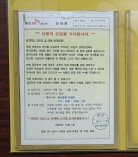Huawei makes waves with chip technology
Huawei makes waves with chip technology
Posted September. 12, 2023 08:32,
Updated September. 12, 2023 08:32
The world is putting puzzle pieces together after Huawei introduced the Mate 60 Pro Plus in China, a new 5G smartphone that was released despite U.S. semiconductor export restrictions. The U.S. Department of Commerce has initiated an investigation, and global semiconductor companies and financial investors are conducting their own analyses to determine whether Huawei's technology is a bluff, an innovation, or something in between.
A 7nm (nanometer) semiconductor process designed by Huawei and manufactured by the Chinese foundry SMIC has garnered attention as a testament to the growth of China's chip ecosystem, encompassing semiconductor design, equipment, and foundry services. This technology lags more than five years behind the leading players, such as TSMC and Samsung Electronics, who are in a competitive race for the mass production of 3nm chips. Nevertheless, there is a consensus that the company has exceeded expectations by succeeding in mass production despite being isolated from the Western semiconductor ecosystem. Analyst firm TechInsights dismantled the phone and confirmed the presence of a 7-nanometer chip.
However, the question of whether Huawei used its own technology remains unanswered. Just days before Huawei unveiled the smartphone for sale on its website, Bloomberg reported that the U.S. Semiconductor Industry Association (SIA) had warned its members, urging caution when dealing with Huawei. It said that Huawei, which has been blocked from doing business with U.S. companies since it became a direct target of U.S. President Donald Trump's administration in 2019, was hiding behind other companies to acquire two semiconductor factories in China and set up three factories. If these deals were indeed finalized, it would enable Huawei to procure U.S. semiconductor equipment through these factories, which had been secretly acquired under the names of other companies.
Whether the yield is high enough for mass production is another question. Even Wall Street is skeptical that the company has achieved competitive yields in the market without substantial subsidies from the Chinese government. Furthermore, Dutch company ASML's deep ultraviolet (DUV) lithography equipment, which SMIC is believed to have used for producing 7-nanometer process semiconductors, is effectively prohibited from being exported to China as of this month. Apart from Chinese pride, this situation implies that there will be significant challenges ahead. Meanwhile, the gap between its technology and that of South Korean and Taiwanese semiconductor companies could potentially widen further.
But we cannot let our guard down. In the technology sector, it's not uncommon for seemingly impossible things to come together under the right circumstances to change industry leadership. When Samsung's late founder, Lee Byung-chul, announced his intention to enter the semiconductor market in 1982 through the 'Tokyo Declaration,' Intel and the world scoffed at the idea. However, a combination of massive investments, the passion of developers, and the special circumstances of the U.S.-Japan semiconductor trade conflict gave Korea the opportunity to become a semiconductor powerhouse.
In the tech industry, a single moment can completely change the market landscape. We need to remind ourselves that any bluff can transform into innovation. In an uncertain world where we don't know where the sparks of the U.S.-China conflict will ignite, we must set aside arrogance.



![범퍼에 고라니 낀 줄도 모르고…버젓이 주차한 운전자[e글e글]](https://dimg.donga.com/c/138/175/90/1/wps/NEWS/IMAGE/2025/12/11/132946797.3.jpg)



